The focus on innovation in education is exciting! Over the past year, I have found many amazing ideas on Twitter, from George Couros, and from Tony Wagner that have sparked discussions with colleagues and inspired my vision of what learning should be, for both students and teachers. Yet, I often feel frustrated that the day-to-day structure of school remains the same, and I’m not even sure where to begin to make a change.
Then I read this. This. Thank you Nathan Lang.

Instead of focusing on how to change education, what if we focus on how education can be a tool to change the world? We know that students learn best when they are motivated, and find the concepts and skills meaningful and relevant to them. What could be more meaningful and relevant than making their world a better place? The purpose of education should be for students to seek out problems around them and learn how to solve them.
We don’t necessarily need to innovate everything in education. But, we do need our students to be innovators. How can we inspire our students to become innovators?
They need to develop these 21st-century core competencies:
- problem seeking and solving, which requires students to be curious, to ask the right questions, think critically, and be empathetic to those around them
- an entrepreneurial spirit to seek out change and work toward continuous improvement
- collaboration that honors multiple perspectives and truly incorporates the ideas and input of everyone in the group
- an interdisciplinary approach to problems that allows students to make connections between disciplines and know how to find and use the information needed
- the ability to communicate and share ideas, not just in written and oral forms, but in a variety of ways, using a variety of platforms
- an intrinsic motivation to persevere through endless iterations, always reflecting on successes and challenges
If these core competencies are the focus of education, students will be able to design and create real products and solutions that can be put into place…today! They shouldn’t have to wait to use what they are learning. They should be applying it as they are learning.
At a recent student panel, I was excited to hear amazing examples of how students are making a difference in the world, by creating apps, giving informational talks, and leading clubs. Then, I realized that most of their work was being done after-school or beyond the school walls. How can we incorporate more of this into our existing curriculum and provide opportunities for all students to design and lead these types of projects as a part of the school-day?
I’m excited by the #STEMpathy projects our ES STEM teacher has been planning and look forward to sharing them soon. In addition, our HS STEM teacher has asked teachers to suggest problems they face each day, and students will design and implement a solution for them. How can we move this type of thinking beyond the STEM labs and Makerspaces, and into all classrooms?